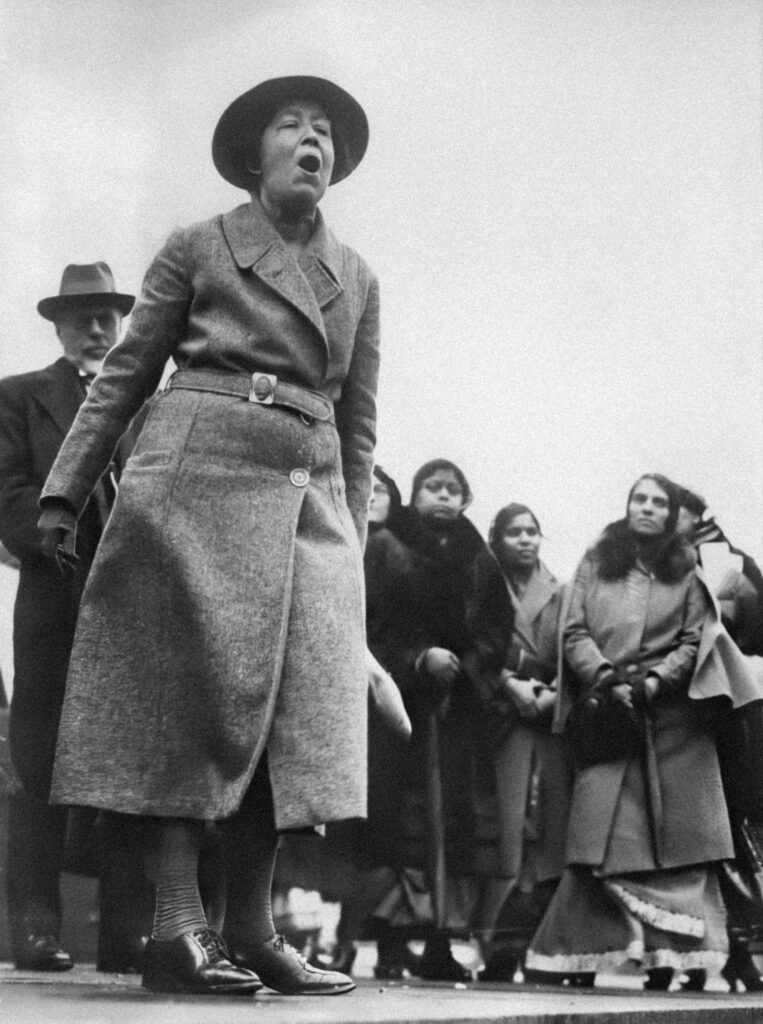
In the midst of a highly polarized political climate, many individuals across the nation find themselves grappling with heightened levels of voter anxiety and election anxiety. The constant barrage of news coverage, social media discussions, and political debates can leave individuals feeling overwhelmed, stressed, and uncertain about the future. As we approach the upcoming US Presidential Election, it is crucial to address the mental health impact of this turbulent period and explore strategies to mitigate voting anxiety for a restful night.
Understanding the Impact of a Polarized Political Climate on Mental Health
The heightened state of polarization in the United States' political sphere has undeniably ushered in a wave of increased anxiety amongst the electorate. Election anxiety is real, and it can induce everything from insomnia to panic attacks. Anxiety levels rise in the lead-up to an election, peak on election day, and then fall slightly afterward. This era, characterized by sharply divided opinions and relentless streams of often conflicting information, casts a long shadow over individuals' mental health. The relentless exposure to divisive rhetoric and the high stakes attached to political outcomes can foster a breeding ground for stress, fear, and uncertainty. Individuals may find themselves ensnared in a web of worry, attempting to decipher complex political narratives that seem to shift with the wind. This constant state of vigilance, of parsing through information to unearth truth from fiction, exacts a heavy toll on one’s peace of mind.
Amidst this tumultuous backdrop, the emotional and psychological ramifications are palpable. The ceaseless uncertainty and the barrage of polarized viewpoints can lead to a pervasive sense of unease. This can affect an individuals' ability to focus, make decisions, and maintain a sense of normalcy in their daily lives. This psychological strain is not merely fleeting. It seeps into the fabric of one's day-to-day existence, potentially exacerbating pre-existing conditions of anxiety. This all contributes to a heightened state of alertness that wears on the psyche.
In navigating this polarized landscape, the challenge then becomes one of finding a delicate balance - a means to remain informed and engaged without allowing the political climate to overwhelm one's mental equilibrium. It is a tightrope walk of consuming information judiciously, recognizing the impact of political polarization on mental well-being, and taking steps to safeguard one's inner peace amidst the clamor.
The Consequences of Turning Away from Political Engagement

While the allure of retreating from the political fray to shield one's mental health might seem appealing, such a decision carries its own set of repercussions. Individuals who choose to step back from political engagement, driven by a desire to evade the stress and anxiety that often accompanies election seasons, may inadvertently diminish their ability to influence decisions that affect societal and personal realms.
The act of disengaging not only distances them from critical information that could inform their choices and actions but also risks leaving a vacuum where their voices and perspectives are sorely needed.
In a society where every vote and every opinion can contribute to shaping the future, withdrawing from the electoral process can lead to a sense of disconnection and powerlessness. This feeling of being adrift, of lacking agency in the face of significant societal shifts, can exacerbate feelings of anxiety rather than alleviate them. Moreover, this withdrawal from political engagement forfeits the opportunity to be part of constructive change, potentially leaving individuals feeling even more alienated from their communities and the decisions that shape their lives.
The consequences of turning away from political engagement thus extend beyond the individual, affecting the broader fabric of society. When individuals opt out of participating in the democratic process, the diversity of voices that enriches and informs democratic debate diminishes. This reduction in engagement can lead to a less representative and inclusive political landscape, one in which the concerns and needs of various segments of society may not be adequately addressed or heard.
Striking a Balance: Engaging with Care
In the quest to find equilibrium amid the electoral storm, individuals are discovering innovative strategies to manage voting anxiety, ensuring that their engagement with the political process does not come at the expense of their mental health. One critical approach involves a discerning consumption of news, where the focus is on reliable, fact-checked media. This deliberate choice helps mitigate the overwhelming influx of information and the accompanying stress, providing a clearer, more grounded understanding of the political landscape. By limiting exposure to sensationalized narratives and seeking out sources that prioritize accuracy over alarm, individuals can remain informed without being inundated by the constant churn of the news cycle.
Furthermore, this careful engagement extends beyond media consumption to the very essence of civic participation. It encompasses a thoughtful approach to conversations around politics, recognizing the value of empathy and respect in dialogue. In recognizing the diverse perspectives within one's community, there emerges an opportunity to foster connections rather than divisions, even amidst differing viewpoints. This balanced engagement offers a pathway to navigate the charged political atmosphere with a sense of purpose and calm, rather than succumbing to the fray.
Through these measured steps, the act of engaging politically transforms into a practice of self-care, rather than a source of distress. It becomes a testament to the possibility of staying informed and involved, while also safeguarding one's mental and emotional well-being. In this way, individuals can contribute to the democratic process without compromising their peace of mind, navigating the complexities of the current political climate with intention and care.
Prioritizing Self-Care and Mental Well-being

In the whirlwind of election seasons, when the air is thick with debate and the pressure of political outcomes weighs heavily, the importance of self-care becomes paramount for individuals striving to maintain mental well-being. Engaging in self-care practices is not an act of indulgence but a crucial step in ensuring resilience and stability amidst external turmoil.
Individuals find solace in activities that ground them, be it through meditation that quiets the mind, deep breathing exercises that restore balance, or gentle yoga that reconnects the body and spirit. These practices serve as a sanctuary, offering a respite from the relentless pace of political discourse.
Moreover, the foundation of mental well-being is often fortified by the pillars of sleep, nutrition, and physical activity. A commitment to obtaining a restful night's sleep, consuming nourishing foods, and partaking in regular exercise forms a protective barrier against the stressors of the political climate. Such practices not only enhance physical health but are instrumental in mitigating feelings of anxiety and fostering a sense of inner peace.
In a time when external forces seem beyond one's control, prioritizing self-care and mental well-being becomes an act of empowerment. It is a deliberate choice to carve out spaces of tranquility and nurture resilience, ensuring that individuals remain steadfast, not only in the face of the current political maelan, but in all challenges that life may present.
Navigating Conversations and Relationships in a Polarized Environment

In an era where political divisions run deep, individuals often find themselves at a crossroads in conversations and relationships. This may lead to differing views which can easily escalate into conflict. Political party has become a strong social identity. Election anxiety is impacting friendships, families, and even personal mental well-being.
The art of maintaining harmony within these interactions lies in the cultivation of empathy and open-mindedness. It demands a willingness to listen actively, fostering an environment where divergent perspectives are not just tolerated but valued for the depth they add to the dialogue.
Setting healthy boundaries emerges as a critical skill, enabling individuals to engage in meaningful discussions without compromising their emotional well-being. By establishing limits on the nature and extent of political discussions, individuals can protect their mental space. This can ensure that exchanges remain respectful and constructive.
The pursuit of common ground is another vital strategy. It encourages focusing on shared values and goals, rather than fixating on the points of disagreement. This approach not only bridges divides but also strengthens connections, affirming that at the heart of many relationships lies a mutual desire for understanding and respect.
In navigating these interactions, individuals foster a climate of mutual respect. Conversations between these individuals are seen as opportunities for growth and connection. Through this mindful approach, relationships can thrive, even amidst a landscape marked by polarization. It can nurture a sense of unity in an otherwise divided world.
Moving Forward with Resilience and Hope

As society continues to traverse the choppy waters of the current political climate, the embodiment of resilience and hope stands as a guiding light for many. The cultivation of these qualities, deeply intertwined with the conscious efforts to manage mental health and prioritize self-care, illuminates a path forward through the tumult. It is within this journey that individuals discover the strength to face the uncertainties of the political landscape with a steadfast heart and a clear mind. Engaging with the world around them with empathy and thoughtful consideration allows for a compassionate dialogue that transcends division. It fosters a sense of community and shared purpose.
This commitment to navigating challenges with grace and optimism nurtures personal growth and contributes to the collective well-being of society. In embracing a future marked by resilience and hope, individuals can find solace in their ability to adapt and thrive. This can be regardless of the external environment. This forward movement, powered by a collective desire for understanding and connection, heralds a brighter, more inclusive future where dialogue and empathy pave the way for healing and unity.

For many individuals, the concept of mindfulness is synonymous with practices like meditation and visualization. However, what happens when visualization doesn't work for you? How can you still cultivate mindfulness and reap its benefits? In this blog post, we will explore alternatives to traditional mindfulness practices for those who struggle with visualization or meditation. From tailoring the techniques to the individual to incorporating EMDR therapy, there are plenty of options to explore. Let's dive in and discover new ways to embrace mindfulness.
Understanding the Challenges of Traditional Mindfulness Practices

Traditional mindfulness practices like meditation and visualization are celebrated for their benefits in enhancing mental well-being and promoting a state of calm. However, these methods aren't universally effective, posing unique challenges for some individuals. For those who find it difficult to generate mental images, the common visualization techniques can feel frustrating and exclusionary. Similarly, meditation, with its emphasis on stillness and quieting the mind, can be daunting for people who experience restlessness or have an overactive mind.
This discrepancy highlights a crucial point: mindfulness is not a monolithic practice. It is a varied landscape of techniques, each with its own set of obstacles for different people. Recognizing and acknowledging these challenges is the first step toward opening the door to a broader understanding of mindfulness. It underscores the necessity of exploring a range of practices that can accommodate diverse experiences and preferences. As we navigate through these challenges, it becomes evident that flexibility and adaptability in our approach to mindfulness can lead to a more inclusive and beneficial experience for all.
The Importance of Tailoring Mindfulness to the Individual

Mindfulness is not a one-size-fits-all journey. Each person's experiences, challenges, and preferences shape how they can best engage with mindfulness practices. Recognizing this diversity is essential in making mindfulness accessible and effective for everyone. If traditional methods like visualization don't align with your abilities or preferences, it's crucial to remember that this doesn't exclude you from practicing mindfulness. Instead, it invites an opportunity to get creative and explore other techniques that might resonate more deeply with you.
Exploring different mindfulness practices is an act of self-compassion and personal understanding. Whether it's through mindful movement practices such as yoga or tai chi, focusing on the sensations of your breath, or engaging in daily activities with full awareness, there are myriad ways to cultivate mindfulness. The goal is to find practices that not only accommodate your needs. You must also enrich your daily life with moments of presence and awareness.
Engaging with practices that are in harmony with your individual needs can transform your mindfulness journey. This can be from one of frustration to one of discovery and growth. By remaining open to experimentation, you give yourself the space to uncover practices that support your well-being. This can lead to a deeper sense of mindfulness. This personalized approach ensures that your mindfulness practice is not only sustainable but also a source of joy and discovery in your life.
Practical Mindfulness Techniques Without Visualization
Exploring mindfulness beyond visualization opens up a wealth of possibilities for engaging with the present moment in a meaningful way. For those who find it challenging to conjure mental images, focusing on tangible, sensory experiences can serve as an effective alternative. One simple yet powerful technique is mindful listening. This practice involves paying full attention to the sounds around you. This can be the rhythmic patter of rain, the distant hum of traffic, or the subtle shifts in a room. By tuning into the auditory landscape, you can anchor yourself in the now without the need for visualization.
Another approach is to engage in tactile activities that ground you in the physicality of the present. Activities such as kneading dough, playing with clay, or even the act of cleaning can become mindfulness exercises. Just approach it with full awareness of the sensations in your hands and the movements of your body. These activities offer a direct pathway to mindfulness by leveraging the sense of touch, drawing your focus away from the whirlwind of thoughts and into the realm of tactile experience.
Mindful eating presents yet another avenue for cultivating mindfulness without visualization. By slowing down and truly savoring each bite, paying attention to the textures, flavors, and aromas of your food, you transform a routine activity into a deliberate practice of presence. Each of these techniques provides a unique way to experience mindfulness. It emphasizes the richness of the present moment through the senses rather than through visual imagery.
The Role of EMDR in Achieving Mindfulness
EMDR (Eye Movement Desensitization and Reprocessing) offers a unique contribution to the mindfulness journey, especially for individuals grappling with trauma. Although it primarily serves as a therapeutic tool for processing traumatic memories, its benefits extend to enhancing mindfulness. EMDR facilitates a deep engagement with the present moment. This is done by addressing and healing the emotional distress that can tether the mind to past events. This therapeutic process encourages an increased awareness and acceptance of one’s emotional state and thought patterns. It lays the groundwork for a more mindful way of living.
Through bilateral stimulation, typically involving eye movements, EMDR helps to unlock emotional processing that may be stuck, allowing individuals to experience relief from emotional blockages. As these blockages are addressed, individuals often find it easier to access states of mindfulness. This is due to their capacity for emotional regulation and presence in the now that is significantly improved. Engaging in EMDR therapy under the guidance of a skilled practitioner not only aids in the healing of past wounds but also enriches the pursuit of mindfulness by fostering a deeper connection with the self and the surrounding world.
Incorporating Mindfulness into Daily Activities

Integrating mindfulness into the fabric of everyday life can transform mundane tasks into opportunities for presence and awareness. Instead of seeing activities like brushing your teeth, taking a shower, or commuting to work as mere chores or routines, view them through a mindfulness lens. Focus on the feel of the toothbrush against your gums, the water cascading over your skin, or the rhythm of your footsteps. Each action offers a chance to ground yourself in the current moment.
Notice the colors, sounds, and sensations around you without judgment. Pay attention to your breathing as you move through these tasks. Allow each breath to bring you closer to a state of calm and focus. This practice doesn't require extra time out of your day but simply a shift in perspective and intention. By embedding mindfulness into these daily activities, you create a continuous thread of awareness throughout your day. This can make mindfulness an accessible and seamless part of your life.
Mindfulness Apps and Tools That Don't Rely on Visualization
In our technologically advanced world, a vast array of mindfulness resources is available at our fingertips. They are designed to cater to those who may not find visualization-based practices accessible or effective. Various applications and digital platforms provide a wealth of guided exercises, focusing on techniques such as mindful breathing, auditory practices, and body scans that do not require the user to visualize but instead to tune into other senses or aspects of their experience.
For example, Insight Timer features a wide range of mindfulness and meditation sessions focusing on sound. It has thousands of guided audio meditations from practitioners around the globe. Similarly, Headspace offers sessions centered on mindful techniques like noting and body scanning. This encourages users to pay attention to their thoughts, feelings, and physical sensations without the need to visualize. The Calm app also provides a plethora of mindfulness exercises, including daily calm sessions and sleep stories, that focus on the auditory experience and the practice of being present through listening and sensing.
These tools not only support those who prefer or require alternatives to visualization-based mindfulness but also enhance accessibility. It allows users to explore mindfulness in a way that aligns with their personal preferences and needs. By integrating these apps and tools into your mindfulness practice, you can discover new pathways to presence and awareness without relying on visual imagery.
The Benefits of Non-Traditional Mindfulness Practices
Embracing non-traditional mindfulness practices offers a multitude of advantages for those seeking alternatives to visualization and conventional meditation. These practices encourage an exploration of mindfulness through diverse sensory experiences and activities. This allows for a broader understanding and appreciation of the present moment. By engaging in mindfulness techniques that utilize sound, touch, or mindful movement, individuals can discover a deeper connection to their environment and inner self.
This inclusive approach ensures that mindfulness is accessible to everyone, regardless of their ability to visualize or sit in meditation. It promotes a sense of grounding and awareness that is both practical and profound, integrating seamlessly into everyday life. As you embark on this varied mindfulness journey, you will likely notice an enhancement in your capacity for emotional regulation, stress reduction, and overall well-being. The flexibility and adaptability of non-traditional mindfulness practices make them a valuable resource for cultivating a peaceful mind and a more mindful life, tailored uniquely to each individual's path.

Managing anxiety as a working parent can be an overwhelming task. Balancing the demands of work, family, and personal life can easily lead to feelings of stress and anxiety. In this blog post, we will explore some life hacks to help you manage anxiety and navigate the busy world of working parents.
Understanding the Roots of Your Anxiety
To effectively manage anxiety as a working parent, it's critical to pinpoint what specifically sparks these feelings. Anxiety can stem from a myriad of sources. This can be from, deadlines at work, the pressure of familial obligations, or even the internal quest for personal achievement. Delving into these triggers allows for a targeted approach in mitigating stress.
Reflect on moments when anxiety feels most potent and consider journaling these instances to uncover patterns or common themes. This process is not about placing blame but rather gaining insight into your emotional responses. By acknowledging these triggers, you equip yourself with the knowledge to develop tailored strategies. This can address your unique challenges, setting the stage for a more balanced and serene daily life.
Starting the Day on a Positive Note

Kicking off the morning with a positive mindset is a game changer for managing anxiety as a working parent. Consider implementing a morning ritual that nurtures your mental and emotional well-being. This could range from writing down three things you're grateful for, to visualizing your day unfolding in a positive way, or simply enjoying a quiet moment with your favorite cup of tea before the day begins. These practices not only help in setting a tone of gratitude and intentionality for the day but also equip you with a serene mindset to face the day's hurdles.
Engaging in physical activities can also invigorate your body and clear your mind, providing a double benefit. This can include a brief morning walk or yoga session. Incorporating such practices into your morning routine can significantly diminish anxiety levels. It can also boost your confidence to tackle the day ahead. Emphasizing this proactive start can be a cornerstone for a more balanced and joyful experience as a working parent.
Strategies for Effective Time Management
Mastering time management is key for alleviating anxiety for the working parent. An organized approach to your day can make a significant difference in how you perceive and handle stress. Begin by breaking down your tasks into manageable chunks, categorizing them by urgency and importance. This strategy enables you to focus on what truly needs your attention. It reduces the overwhelming feeling that everything is a priority. Utilize digital tools or planners to map out your week, allocating specific time slots for work commitments, family activities, and crucially, self-care and relaxation.
This holistic view of your schedule not only helps in balancing your responsibilities. It also in identifies opportunities to delegate tasks, whether at work or home. Remember, it's about working smarter, not harder. Effective time management also involves setting realistic deadlines and learning to say 'no' when necessary to avoid overcommitment. Each step taken to organize your time better is a step towards a less anxious and more fulfilling life as a working parent.
The Power of Mindfulness Throughout the Day

Incorporating mindfulness into your daily life as a working parent can act as a powerful tool to diminish anxiety and elevate your sense of well-being. This practice enables you to engage more fully with the present moment. It reduces the impact of stress and fostering a calm, focused state of mind. Throughout the day, find moments to pause and breathe deeply, centering yourself amidst the day's demands. These brief interludes of mindfulness can be as simple as taking a minute to notice the sensations of your breath or feeling the texture of an object in your hands, providing a quick reset for your mental state.
Consider setting reminders on your phone or computer to prompt these mindfulness breaks. This is especially useful during times you know are particularly stressful. During these pauses, focus solely on the present experience, letting go of concerns about past or future events. This practice can help break the cycle of continuous worry and anxiety that often accompanies the role of a working parent.
Additionally, incorporating mindfulness exercises can further enhance your ability to remain centered throughout the day. An examples of this can be focused breathing or mindful listening. By dedicating time to cultivate mindfulness, you pave the way for a more peaceful and present engagement with both your work and family life. This in turn, helps to manage anxiety with grace and resilience.
Building a Support System at Work and Home
Cultivating a reliable support network is pivotal for navigating the pressures of being a working parent with less anxiety. Engage with colleagues who understand your commitment to both your career and family. These connections can offer practical advice or a listening ear when you need it most. Don't hesitate to lean on friends or family members who can offer support. This can be lending an ear after a tough day or assisting with childcare duties.
An open dialogue with your partner about shared responsibilities and emotional support is also crucial. This collaborative approach not only eases personal stress but strengthens relationships by fostering mutual understanding and support. Additionally, exploring community resources or online support groups for working parents can extend your network. It can provide further opportunities for connection and advice. By proactively building and nurturing these support systems, you create a foundation of assistance and camaraderie that makes managing anxiety more achievable.
The Role of Physical Health in Managing Anxiety

Acknowledging the significant impact of physical health on anxiety management is vital for working parents. Engaging in regular physical activity is not just about keeping fit; it's a proven stress-reliever that can elevate your mood and enhance mental clarity. Finding an exercise regimen that fits into your busy schedule, whether it's a quick morning workout, a brisk walk during lunch breaks, or a yoga session to unwind in the evening, can be immensely beneficial.
Healthy dietary habits complement this approach, fueling your body with the nutrients it needs to combat stress effectively. Opt for whole foods rich in antioxidants, lean proteins, and healthy fats to keep your energy levels stable throughout the day. Equally important is ensuring you get adequate rest. Sleep deprivation can exacerbate anxiety, making it harder to cope with daily pressures. Strive to create a restful sleep environment and establish a calming bedtime routine to improve your sleep quality. Making these lifestyle choices a priority not only supports your physical well-being but also builds resilience against anxiety, enabling you to meet the demands of both your professional and personal life with greater ease and less stress.
Embracing Imperfection and Practicing Self-Compassion
In the journey of a working parent, it’s essential to acknowledge that perfection is unattainable. The pressures to excel in every aspect of life can be immense, yet it's crucial to understand that making mistakes or falling short at times is inherently human. Embracing imperfection allows us to see these moments not as failures, but as opportunities for growth and learning. This shift in perspective is liberating, reducing the anxiety that comes from striving for the unachievable.
Practicing self-compassion is equally important. It involves treating yourself with the same kindness and understanding you would offer to a friend in distress. When faced with challenges or setbacks, respond with empathy towards yourself, recognizing the difficult emotions without judgment. This gentle approach can significantly lessen the burden of anxiety. It encourages a healthier, more forgiving attitude towards oneself, fostering resilience in the face of day-to-day stressors. Remember, the journey of managing anxiety as a working parent is not about reaching perfection but about navigating the complexities of life with grace, understanding, and self-compassion.
Finding Joy in the Little Moments
In the whirlwind of daily responsibilities, it's easy for working parents to overlook the small, joyous moments that life offers. However, cultivating a habit of noticing and appreciating these instances can significantly counterbalance anxiety. Whether it's sharing a laugh with your child over breakfast, enjoying the quiet of the morning before everyone else wakes up, or feeling the satisfaction of ticking off an item on your to-do list, these moments are pockets of joy and peace amidst the chaos. Make it a point to consciously acknowledge them.
Perhaps, keep a joy journal where you jot down one thing each day that brought you happiness or made you smile. Over time, this practice not only becomes a repository of positive memories but also a reminder that happiness exists in the minutiae of everyday life. Encouraging your family to share their joyful moments can further amplify this effect, fostering an environment of positivity and gratitude. By valuing these small victories and pleasures, you can cultivate a more joyful, less anxious perspective on life, enhancing your overall well-being and that of your family.

In today's digital age, teaching has become more challenging than ever before. With the rise of millennial parenting styles and the prevalence of social media addiction across all age groups, educators are facing unprecedented levels of stress and burnout. Fortunately, Eye Movement Desensitization and Reprocessing (EMDR) therapy offers a promising solution to help teachers cope with the demands of their profession and support their students in navigating the complexities of modern education.
The Landscape of Modern Education and Millennial Challenges
The transformation of the educational environment in recent years has been profound, significantly influenced by the distinctive child-rearing practices of millennial parents. This generation of parents, having grown up with technology at their fingertips, often adopts a tech-savvy approach to parenting. This emphases open lines of communication and a partnership-oriented relationship with educators. However, this dynamic can lead to complexities in the classroom, as teachers strive to balance the digital-first expectations of millennial parents with the traditional educational values and practices.
Additionally, the millennial emphasis on individualized attention and customized learning experiences for their children can place added pressure on educators. People, who must navigate these demands while addressing the diverse needs of their entire student body. This shift has not only changed the way educators teach but also how they interact with parents. It requires new strategies and approaches to foster effective partnerships and promote student success in an ever-evolving educational landscape.
Understanding Social Media Addiction Across Ages

Social media's grasp extends far beyond a simple distraction. It weaves into the very fabric of students' lives across various age groups, cultivating an environment ripe for addiction. This pervasive issue sees young minds constantly battling for concentration amidst a barrage of notifications and digital interactions. It significantly impairs their academic capabilities and focus.
The allure of likes, shares, and instant communication holds a compelling sway, leading to a reduction in meaningful, face-to-face interactions and a dependency on digital validation.
Such addiction does not merely hinder educational outcomes. It also seeps into the mental health arena, potentially exacerbating feelings of isolation, anxiety, and depression among students. This complex web of digital engagement requires educators to adopt nuanced strategies to mitigate its impact. This encourages healthier online habits and fostering environments that prioritize both academic and emotional growth. In addressing social media addiction, the goal is to reclaim the attention and well-being of students, guiding them towards balanced, responsible use of technology.
The Psychological Toll on Educators

Navigating the dual pressures of millennial parenting expectations and the pervasive influence of social media, educators are enduring a significant psychological toll. The constant endeavor to balance digital-first approaches with traditional teaching methodologies. This, coupled with the need to engage students deeply entrenched in the digital world, places a unique strain on teachers. This relentless pressure exacerbates stress, propelling many towards feelings of anxiety and burnout.
Such emotional and mental fatigue not only impairs their capacity to provide high-quality education but also affects their personal well-being. The intensity of these challenges often leaves educators seeking strategies to safeguard their mental health while maintaining their commitment to fostering an enriching learning environment. In this milieu, the necessity for supportive interventions and coping mechanisms becomes paramount. It highlights the need for resources that can aid in managing the intricate dynamics of modern education.
Introduction to EMDR Therapy
EMDR therapy stands as a transformative approach within the therapeutic world. It is designed to aid individuals in processing and overcoming trauma, anxiety, and stress-related symptoms. This method employs bilateral stimulation, through eye movements or tactile tapping. It is a mechanism to facilitate the brain's processing of distressing memories and beliefs that contribute to emotional discomfort. Originating as a treatment for PTSD, its applications have broadened, showing effectiveness in addressing a range of psychological stressors. EMDR's unique capacity to accelerate the mind's natural healing processes presents a novel avenue for educators and students alike, grappling with the pressures of modern educational environments and digital disruptions.
Through targeted sessions, participants can experience relief from psychological burdens. It can pave the way for enhanced coping mechanisms and a renewed sense of mental clarity. This foundation in EMDR therapy elucidates its potential as a supportive tool in educational settings, aimed at ameliorating the emotional and cognitive challenges faced by today’s teachers and learners.
EMDR Therapy for Students

EMDR therapy holds significant potential for students ensnared in the challenges of navigating a digital-centric lifestyle and the stressors inherent in modern academic environments. This therapeutic approach is particularly adept at addressing the deep-seated psychological effects of social media overuse. This often manifest as heightened anxiety, decreased self-esteem, and impaired focus. Through the process of bilateral stimulation, students are guided to confront and reprocess negative beliefs or traumatic experiences that may be exacerbating their reliance on digital validation and hindering their academic and social development.
By integrating EMDR into student support services, educational institutions can offer a proactive pathway for students to break free from the cycle of digital dependency and its accompanying mental health issues. This not only aids in enhancing their emotional regulation and resilience but also cultivates a healthier relationship with technology. As students learn to manage their emotional responses and build a stronger sense of self-worth independent of online feedback, they're better equipped to engage fully with their educational journey.
Such therapeutic interventions can be instrumental in reorienting students toward more productive coping mechanisms. This encourages a shift from virtual spaces to real-world connections and learning. The adoption of EMDR therapy for student support underscores a commitment to nurturing not only the intellectual but also the emotional and psychological well-being of learners. It prepares them for a balanced and successful path through school and into adulthood.
Implementing EMDR in Educational Settings
The integration of EMDR therapy within schools represents a strategic approach to addressing the psychological challenges facing today's educational community. Key to this implementation is the professional development of educators and school mental health professionals, and equipping them with the skills necessary to facilitate EMDR techniques. Providing access to EMDR-trained therapists on campus can greatly enhance the support system available to both teachers and students.
Additionally, developing partnerships with local mental health organizations can expand resources and ensure a broad spectrum of support. Workshops and informational sessions could be organized to demystify EMDR therapy for the school community. It can highlight its benefits and potential to improve academic and emotional outcomes. By fostering an environment that values mental health as much as academic achievement, schools can cultivate resilience and well-being across their populations. This will empowers educators and learners to navigate the complexities of the digital age with confidence and support.
Conclusion and Moving Forward
The challenges presented by the intersection of millennial parenting, media addiction, and the demands of modern education require innovative solutions. EMDR therapy represents a powerful tool in this quest. It offers both educators and students a pathway to better mental health and resilience. As we look to the future, the importance of integrating psychological well-being strategies into the fabric of our educational systems cannot be overstated. Schools must become places where mental health resources, like EMDR, are readily accessible to address the complexities of today's digital and educational landscapes.
By equipping our teachers with the means to manage stress and burnout effectively, and providing our students with the skills to navigate their digital world healthily, we set the stage for a more positive and productive learning environment. The journey ahead will require commitment, collaboration, and open-mindedness from all stakeholders in the educational community. Embracing EMDR therapy as part of a comprehensive approach to mental health in schools is a critical step toward fostering an environment where everyone can thrive amidst the challenges of the 21st century.

In the realm of family dynamics, the role of fathers has often been overshadowed by the traditional notion that their primary duty is to provide financial support. This limited perspective underestimates the value that fathers bring beyond their wallets, leaving mothers to bear the weight of full-time jobs and childcare responsibilities alone. This skewed expectation not only overburdens mothers but also sends damaging messages to our children about gender roles and relationships. It's time to shed light on the critical role of fathers in child-rearing and household responsibilities. To challenge the outdated belief that active paternal involvement compromises masculinity.
The Evolution of Fatherhood in Family Dynamics
As society's norms and expectations have progressed, so too has the perception and reality of fatherhood within family dynamics. The traditional image of the father as merely a provider has transformed, giving way to a more comprehensive view that encompasses emotional, mental, and physical involvement. This transformation acknowledges fathers as crucial figures for emotional support, guidance, discipline, and active participation in day-to-day childcare. The evolution is partly driven by the changing landscape of the workforce, with more mothers entering full-time employment, thereby necessitating a shift in domestic roles. Additionally, a growing body of research underscores the positive impact of father engagement on child development, challenging old paradigms and encouraging a new generation of dads to embrace a hands-on approach to parenting.
This shift away from rigid gender roles towards a more egalitarian model not only enriches the father-child relationship but also contributes to a more balanced distribution of household and parenting responsibilities. As we continue to navigate these changing dynamics, it becomes clear that the modern father’s role is as much about emotional nurture and participation in the home as it is about providing financial support, marking a significant step towards a more inclusive understanding of fatherhood in today's world.
Unpacking the Financial Provider Stereotype

The stereotype that fathers primarily serve as financial providers has deep roots, yet it confines their role to a singular dimension that overlooks their broader impact on family life. This archetype not only restricts fathers' involvement in nurturing and caregiving but also devalues their potential to contribute in emotionally supportive ways.
Moving beyond this stereotype allows fathers to explore a full spectrum of parenting, from sharing in the joys and challenges of day-to-day child-rearing to being an active participant in household decisions and chores.
Embracing a more holistic view of fatherhood enables dads to forge stronger bonds with their children, offering them a model of gender inclusivity and emotional intelligence. Additionally, this shift can alleviate some of the pressures traditionally placed on mothers, promoting a more equitable sharing of parental duties. This reevaluation of the father's role challenges societal norms and encourages a family dynamic where both parents' contributions are acknowledged and valued, not simply for their economic worth but for their integral part in fostering a nurturing, supportive, and resilient family unit.
The Impact on Mothers and the Family Unit

When fathers actively engage in parenting and household responsibilities, the impact on mothers and the overall family unit is profound. Mothers, traditionally burdened with the lion's share of caregiving and domestic tasks, experience a significant alleviation of stress and an increased sense of partnership. This shared responsibility fosters a healthier work-life balance for both parents, reducing maternal burnout and enhancing family well-being. Moreover, it sets a powerful example for children, who learn the importance of equality, teamwork, and mutual support within the family.
By witnessing their fathers' active participation, children grow up with a more balanced view of gender roles, understanding that caregiving and emotional support are not solely women's responsibilities. This balanced approach to parenting leads to happier, more harmonious home environments, where all members feel valued and supported. The ripple effect of such dynamics encourages a culture of respect and collaboration, essential qualities for healthy, functional relationships both within and outside the family unit.
Breaking Down Gender Roles and Relationships
In today's society, the persistence of conventional gender roles continues to confine parents to outdated expectations that do not reflect the complexities of modern family life. By holding onto the belief that fathers should be the primary earners and mothers the chief caregivers, we limit the potential for a richer, more balanced familial interaction. This adherence to traditional roles not only hampers the emotional development and involvement of fathers but also unjustly burdens mothers with a disproportionate share of domestic and caregiving responsibilities. To foster a family dynamic that thrives on mutual respect, understanding, and shared duties, it is imperative to move beyond these archaic constructs.
Encouraging a departure from these norms enables families to model a dynamic of equality and shared responsibility, offering children a broader, more inclusive view of what it means to contribute to family life. In doing so, we not only challenge the status quo but also empower each family member to engage fully and authentically in their roles, free from the constraints of societal expectations. This shift towards a more egalitarian approach in parenting and household responsibilities is crucial for cultivating an environment where both parents can flourish in their individual and collective roles, demonstrating to children the value of collaboration, respect, and flexibility in family relationships and beyond.
The Myth of Masculinity and Parental Involvement

The prevailing notion that active fatherhood detracts from a man's masculinity is a significant impediment to balanced family involvement. This myth, deeply ingrained in societal norms, suggests that emotional availability and caregiving are at odds with traditional male characteristics. However, embracing these roles actually demonstrates profound strength and self-assurance. It is crucial to redefine masculinity to include the tenderness, empathy, and involvement in day-to-day family life that contribute to the holistic development of children. By challenging these outdated perceptions, fathers can reclaim their rightful place in the emotional and physical landscape of parenting.
This transformation not only benefits their relationships with their children but also models for future generations a more inclusive definition of what it means to be a man. Encouraging men to dismantle these barriers and engage fully in all aspects of parenting supports a family dynamic rich with diversity in care and interaction. The journey toward redefining masculinity to encompass the full spectrum of parental involvement is a vital step in fostering families where every member can thrive in an atmosphere of mutual respect and shared responsibilities.
The Benefits of Co-Parenting
Embracing co-parenting leads to a wealth of advantages that extend across the entire family unit. Children thrive under the care of both parents, gaining access to varied life lessons, emotional support, and a deeper sense of security. This dual involvement helps in the development of well-rounded individuals by exposing them to diverse problem-solving approaches, coping mechanisms, and nurturing styles. For parents, the shared responsibility lightens the individual burden, creating space for personal growth and stronger marital relationships.
The cooperative effort in parenting responsibilities fosters an environment of mutual respect and understanding, significantly reducing the potential for conflict and resentment. Such a dynamic promotes effective communication and teamwork, laying a solid foundation for children to learn valuable interpersonal skills. Furthermore, engaging in co-parenting allows for a more balanced lifestyle, where both parents can pursue their career ambitions while ensuring their family life remains a top priority. This approach not only enriches the parental experience but also models a healthy, collaborative, and supportive relationship for children, setting a precedent for their future relationships and parenting styles.
A Call to Action for Men and Women

The moment has arrived for a significant cultural shift in our understanding and appreciation of fatherhood within the context of family life. Both men and women must advocate for a more inclusive approach to parenting, highlighting the indispensable role fathers play in the emotional and developmental growth of their children. This endeavor requires a collective effort to dismantle the deep-seated stereotypes that limit paternal involvement to financial contributions. We need to foster an environment where fathers feel empowered and expected to engage deeply in the parenting process, from the tender moments of infancy to the complex challenges of adolescence.
Promoting the concept of co-parenting as a societal norm rather than an exception is essential. This includes encouraging workplaces to recognize and support the parenting roles of both fathers and mothers, thereby facilitating a more balanced distribution of domestic and professional responsibilities. Additionally, educational initiatives aimed at new and expecting parents can provide the tools and confidence needed for fathers to embrace their roles fully.
By uniting in this cause, we stand to benefit the fabric of our families, enhancing the well-being of all members and providing our children with a model of equality, cooperation, and respect. It’s about cultivating a generation that values emotional intelligence and mutual support, setting the stage for a future where the nurturing influence of both parents is not just welcomed, but expected. Let's commit to championing this change, for the betterment of our families and society at large.

Experiencing or witnessing a profoundly distressing or threatening event can lead to the development of post-traumatic stress disorder, commonly known as PTSD. When you have PTSD, you get very anxious. Also, you have nightmares or relive the event that caused you to feel like that. Very often, it’s too much to take. To go through this, you might begin drinking. You might even try extremely dangerous substances just to be able to cope with your emotions. That is how you become dependent on substances. We will show you how PTSD and addiction are connected and how they make each other worse. When you understand this, you will make informed decisions, ask for professional help, and start living healthier lives.
What is PTSD?
Post-traumatic stress disorder (PTSD) is a mental health condition. It is triggered when you experience or witness a traumatic event. Many signs of trauma can help you recognize this condition. You might get flashbacks of that event, see nightmares, or feel severely anxious. Also, you might have uncontrollable thoughts about it.
Some common triggers of PTSD are:
● Military combat
● Serious accidents, like car crashes
● Natural disasters, like floods or earthquakes
● Violent personal assaults, such as robbery or attack
● Abuse or domestic violence.
How PTSD affects daily life
It is not easy to live with PTSD. What happens is - you feel scared or nervous, even in safe situations. You tend to avoid places or people that bring back the memories connected to the trauma. Your sleep gets disrupted, as well. You can’t concentrate, and you feel angry and irritable. Much of the time, you feel sad.
Of course, having these feelings makes it hard to do everyday activities. For example, working, going to school, or even socializing is difficult. Unfortunately, your relationships suffer, as well.

What is addiction?
Addiction is a serious condition where you become unable to stop using a substance, even though it causes harm to your health, relationships, and daily responsibilities. You change your brain’s reward system when you use the substance repeatedly. That makes your brain dependent on the substance. You can become addicted to many different substances, such as:
● Alcohol,
● Prescription drugs like painkillers or sedatives,
● Illegal drugs like heroin, cocaine, or methamphetamine,
● Nicotine, found in cigarettes and vaping products.
How addiction starts and affects your life
Addiction starts with the repeated use of a substance. At first, you feel the effects of the substance strongly. Then, when you start using regularly, your body becomes tolerant. This tolerance means that you now need higher amounts of the substance to get the same feeling. The substance becomes a central part of your life as you consume more. This dependence on the substance can spiral into addiction.
Once addiction takes hold, it can disrupt various aspects of your life. Here are some of its effects:
- Health complications: Chronic use can lead to severe health issues such as heart, lung, and liver diseases.
- Relationship strain: Behavioral changes associated with addiction can damage your relationships with loved ones.
- Performance issues: Addiction can impair your focus and productivity, causing problems at work or school.
- Economic strain: The costs of sustaining an addiction can lead to financial hardship.
- Legal troubles: Efforts to acquire more substances can sometimes result in legal issues.
How PTSD and addiction are connected, and their impact
How do PTSD and addiction relate? Experiencing PTSD often entails grappling with overwhelming feelings of unease, tension, or profound melancholy. These emotions can become so overwhelming that you might feel trapped or powerless. Seeking solace, one might turn to substances like alcohol or drugs for temporary respite. This transient respite underscores the direct link between PTSD and addiction. For instance, if recurrent nightmares disrupt your sleep, indulging in alcohol may momentarily offer a sense of escape, aiding in relaxation and reducing feelings of overwhelm. Nevertheless, this respite is brief and can swiftly foster a dependency on such substances merely to restore a semblance of equilibrium.

Impact of PTSD and addiction on health
When you suffer from PTSD and addiction in combination, the risk of heart disease is higher. That happens because there are harmful effects of substances that go together with stress. Your liver gets damaged, too. It processes the substances you use, especially if you use a lot or very often. Furthermore, stress and using drugs and alcohol will weaken your immune system. That puts you in a bad position when your body needs to fight infections. Not only that, you get distracted from PTSD symptoms, and substances impair your judgment, which causes accidents and injuries.
There are mental health risks as well. After a very short period, when substance abuse reduces your PTSD symptoms, it starts making them even worse. You are more likely to become depressed. Also, substances affect your cognitive functions. You cannot think anymore, you forget important information, and you can’t make the right decisions.
Treatment options for PTSD and addiction
You need treatment from professionals who know how PTSD and addiction are connected. One important thing about treating PTSD and addiction is to treat them together. When only one condition is addressed, the other condition might continue to affect you. Some effective approaches are:
● Trauma-focused cognitive behavioral therapy (CBT): This helps you identify and change negative thinking and behaviors. It can address both trauma responses and patterns of substance use.
● Eye movement desensitization and reprocessing (EMDR): This therapy is specifically aimed at treating trauma and can be very helpful in processing and reducing the distress from traumatic memories.
● Group therapy: Participating in group sessions can provide support from peers who are dealing with similar issues, which can reduce feelings of isolation and shame.
Choosing the right treatment: The benefit of inpatient rehab facilities
For individuals grappling with the combined challenges of PTSD and substance addiction, the choice of treatment environment is important. Consequently, many New York residents opt for treatment in New Jersey, seeking the quieter, more focused, and often more affordable settings that facilities there can offer, away from the hustle and intense pace of their home state. By choosing a specialized inpatient rehab facility in New Jersey, NY locals can access tailored care that fosters recovery in a conducive environment. These centers offer a controlled environment that is crucial for those who are dealing with severe manifestations of PTSD and dependence on substances. These facilities' continuous access to medical and psychological assistance is indispensable during the initial recovery stages.
Choosing a rehab center in New Jersey, away from the familiar settings of NYC, can also provide strategic benefits. It helps individuals distance themselves from environments that may trigger their PTSD symptoms or substance use, thereby increasing the effectiveness of the recovery efforts. The proximity of New Jersey to New York facilitates family involvement in the recovery process, allowing for regular therapy participation and visits, which are essential components of successful rehabilitation.
Enrolling in an inpatient rehab center can profoundly impact an individual’s recovery trajectory. These centers are specifically prepared to manage the dual diagnosis of PTSD and addiction by implementing therapies designed to address both conditions comprehensively. This holistic approach is crucial as it targets the underlying and overt aspects of the disorders, laying a strong foundation for sustained recovery.
Social support will help you
A study approved by the Institutional Review Board (IRB) at the Medical University of South Carolina shows that you can benefit from social support. There is a greater decrease in the use of substances and PTSD symptoms during treatment when a person has strong social support. It can make treatment more effective.
Look for lasting solutions
We know that drinking and using drugs make you feel better when you cannot cope anymore. However, it is a quick fix. In the long run, it leads to more problems than you think it solves. You get addicted and create a cycle that makes your PTSD symptoms even worse than before. Now that you know how PTSD and addiction are connected, you ought to get help from healthcare experts who understand how PTSD and addiction are connected. They will guide you and help you explore your triggers and traumas, and eventually, you will better your relationships and improve your performance at work or school. You will get to live a more fulfilling and enjoyable life.

Anxiety is a common feeling among Millennials and Gen Z individuals, especially when it comes to the pressure of 'having it all'. In today's society, there is a constant expectation to excel in all areas of life, from career to relationships to finances. This pressure can lead to a significant amount of stress and anxiety, as young adults navigate the challenges of the modern world.
Understanding Financial Anxiety in the Face of an Unpredictable Housing Market

The contemporary housing market presents a formidable challenge for young adults, igniting financial anxiety among Millennials and Gen Z individuals. As property prices soar and availability dwindles, the dream of homeownership seems increasingly out of reach for this demographic. The volatile nature of the market, marked by unexpected fluctuations and fierce competition, adds another layer of uncertainty, exacerbating the stress associated with securing a place to call home.
For many in the 18-25 age group, the aspiration to purchase a home is not only a rite of passage but a significant milestone toward adulthood and financial independence. However, the current economic landscape, characterized by stagnant wages and rising living costs, places this goal firmly in the realm of fantasy for some. The disparity between the housing aspirations of young adults and the harsh realities of the market can lead to a persistent sense of failure and disillusionment.
Renting, often viewed as a temporary solution, has become a long-term reality for numerous Millennials and Gen Z individuals. The instability and lack of security associated with renting can fuel anxiety, leaving many feeling stuck in a cycle of temporary housing arrangements with no clear path to homeownership. This sense of impermanence and the constant threat of rent increases or eviction contribute to the financial pressures weighing on this generation.
Moreover, the competitive housing market forces young adults to make significant financial sacrifices to save for a down payment, sometimes at the expense of other life goals, such as travel or further education. This trade-off, choosing between present enjoyment and future stability, is a source of anxiety and stress, highlighting the difficult decisions faced by young adults in pursuit of the elusive dream of homeownership in an unpredictable housing market.
The Millennial and Gen Z Quest for Work-Life Balance

For Millennials and Gen Z, the concept of work-life balance is often more aspirational than attainable. Raised on the promise that hard work yields success in every arena, these generations face the stark realization that maintaining equilibrium between career aspirations and personal fulfillment is fraught with challenges. The digital age has blurred the lines between work and home, with smartphones ensuring the office is never more than a tap away. This constant connectivity means that switching off from work responsibilities becomes increasingly difficult, contributing to a culture of overwork and burnout.
The traditional 9-to-5 workday has evolved, with many young adults finding themselves in gig economy roles, freelancing, or navigating the precariousness of contract work. While these roles offer flexibility, they also introduce instability, compounding anxiety over financial security and career progression. The pursuit of a fulfilling career, alongside meaningful personal relationships and self-care, creates a juggling act that many find unsustainable in the long term.
Adding to this complexity, Millennials and Gen Z are bombarded with success stories across social media platforms, where peers seemingly manage to excel in their careers while also enjoying a vibrant social life and traveling the world. This digital mirage overlooks the struggles and sacrifices behind the scenes, setting unrealistic benchmarks for personal and professional achievement.
Navigating this landscape requires a recalibration of expectations. It entails recognizing that perfect balance may be an ideal rather than a constant state, understanding the value of boundaries, and the importance of saying no. Prioritizing mental health and recognizing the signs of burnout are crucial steps in this journey. Embracing flexibility, where career growth can coexist with personal well-being, may not eliminate anxiety entirely but can lead to a more sustainable and rewarding approach to work and life.
The Myth of 'Having it All' and Its Impact on Mental Health
The concept of 'having it all'—a fulfilling career, a happy family life, financial prosperity, and personal contentment—has long been a societal benchmark for success, especially for Millennials and Gen Z. This ambitious pursuit, however, often comes at a significant mental health cost. The relentless quest for this idealized lifestyle fosters an environment ripe for anxiety. Individuals grappling with the realities of life's inherent limitations and unexpected challenges. The persistent drive to meet these multifaceted expectations not only fuels feelings of inadequacy but also perpetuates a cycle of chronic stress and disillusionment.
Compounding this issue is the societal glorification of busyness and productivity, which equates one's worth with their output or achievements. This mindset leads to overextension and burnout, further aggravating mental health struggles. The pressure to seamlessly balance professional ambitions with personal desires ignores the complexity of human capabilities and needs. It setts an unrealistic standard that is impossible to maintain consistently.
Moreover, the juxtaposition of personal aspirations against the achievements of others—often magnified by selective sharing on social media—intensifies feelings of failure and inadequacy. This comparison trap can exacerbate feelings of anxiety. It can foster a sense of isolation and disconnection from one's own values and priorities.
Acknowledging the limitations of the 'having it all' paradigm is crucial for mental well-being. It involves embracing the imperfections of life and recognizing that success and fulfillment look different for everyone. Having the understanding that life's worth is not measured by achievements alone, but also by the richness of one's experiences and the depth of their relationships. Shifting focus from societal expectations to personal satisfaction and self-compassion can pave the way for healthier mental and emotional states. This can foster resilience against the inevitable pressures and disappointments life presents.
The Role of Social Media in Amplifying Anxiety

Social media stands as a double-edged sword for Millennials and Gen Z. It can significantly heightening the sense of anxiety among these demographics. Platforms that were originally designed for connection and sharing have morphed into arenas of intense comparison and competition. Users are bombarded with a continuous stream of images and narratives that portray lives of perfection - meticulously curated careers, relationships, and lifestyles. This relentless exposure fosters an environment where young adults feel an incessant pressure to match these often unattainable standards. It ignites feelings of inadequacy and self-doubt.
Additionally, the phenomenon of "FOMO" (fear of missing out) exacerbates this anxiety. Individuals endlessly scroll through depictions of peers engaging in seemingly exciting and enriching experiences. This perception that everyone else is living a more fulfilling life can deepen the sense of isolation and dissatisfaction with one's own reality.
The feedback loop of likes, comments, and shares also plays a pivotal role. For many, these interactions have become a metric of self-worth and validation. The pursuit of digital approval can lead to obsessive behavior. This may mean the quantity of social media engagement dictates one's sense of value and success. This dependency on external validation not only amplifies anxiety but also detracts from the development of intrinsic self-esteem and contentment.
In navigating the challenges presented by social media, it's crucial for young adults to cultivate a critical awareness of its impact on mental health. Establishing boundaries around usage, seeking genuine connections beyond the digital realm, and practicing self-compassion can mitigate the adverse effects. Recognizing that the polished facades often mask the complexity of real life is a vital step in alleviating the pressure and anxiety perpetuated by these platforms.
Strategies for Managing Anxiety and Realigning Expectations

In the journey toward mental wellness, it’s pivotal for Millennials and Gen Z to adopt practical strategies that help manage anxiety and foster a healthy perspective on life's expectations. Engaging in therapy or counseling can provide a supportive environment to navigate these challenges. It can offer insights and tools tailored to individual needs. Mindfulness practices, such as meditation or yoga, can also play a crucial role. It can promote present-moment awareness and reducing stress levels.
Additionally, the power of setting achievable goals cannot be underestimated. By focusing on attainable objectives, individuals can experience a sense of accomplishment that counteracts feelings of inadequacy. It’s also beneficial to prioritize self-care, ensuring that personal needs are met before striving to meet external demands. This might include regular exercise, adequate sleep, and nourishing meals, which all have a direct impact on mental health.
A crucial aspect of managing expectations involves acknowledging that the societal benchmark of 'having it all' is a myth. Embracing life's imperfections and understanding that it’s okay to experience setbacks helps build resilience against the pressure to conform to unrealistic standards. Cultivating a strong support network of friends and family can provide a foundation of acceptance and understanding, reinforcing the idea that worth is not determined by achievement alone.
Finally, learning the art of saying "no" and setting firm boundaries, especially in a digital landscape prone to overstimulation, can safeguard mental health. Detaching from social media periodically can help diminish the influence of comparison. It can foster a more authentic connection with oneself and the immediate world.
By integrating these strategies, Millennials and Gen Z can navigate the complexities of modern life with a more grounded and contented mindset. They can gradually reduce the anxiety associated with the pressure to 'have it all'.

Bringing a new life into this world is an awe-inspiring moment that's often clouded by the unanticipated emotional turmoil of postpartum depression (PPD). If you find yourself feeling unusually despondent, anxious, or overwhelmed after giving birth, it's crucial to recognize that you're not alone in this struggle. Understanding the fine line between normal hormonal changes and symptoms of PPD is the first step toward healing. This guide is designed to walk you through the maze of emotions and help you find your footing again.
Understanding the Normal Hormonal Roller Coaster
The days and weeks following childbirth are a tumultuous time for a new mother's body, largely due to the dramatic hormonal shifts that occur. After delivery, estrogen and progesterone levels, which were significantly elevated during pregnancy, rapidly decline to their pre-pregnancy states. This swift change can significantly impact a mother's emotional and mental state, contributing to mood swings, feelings of sadness, and irritability. These symptoms, often referred to as the "baby blues," are a common experience for many new mothers as their bodies attempt to recalibrate. While unsettling, these feelings are typically short-lived, usually resolving within the first two weeks postpartum. It's crucial for mothers to recognize these hormonal fluctuations as a normal part of the postpartum period, understanding that these emotional responses are a direct result of their body's natural adjustment process.
Identifying the Signs of Postpartum Depression

Identifying the signs of postpartum depression requires a discerning eye, as its manifestations can be far more severe and persistent than those of the typical post-birth hormonal adjustments. Symptoms that might indicate the onset of PPD include a pervasive sense of despair, intense anxiety, or a profound detachment from your newborn, which might feel like an insurmountable gap. You may find yourself struggling with an overwhelming sense of inadequacy as a mother or harbor intrusive thoughts of harm towards yourself or your baby.
Unlike the transient nature of the "baby blues," these feelings linger well beyond the initial two weeks following childbirth. Recognizing these symptoms as potential indicators of PPD is a crucial step in advocating for your mental health. It’s imperative to understand that such experiences, while deeply distressing, are not reflections of your capability or love as a mother but signals that you may need support and treatment to navigate this challenging period.
When and How to Seek Help
If feelings of despair, intense anxiety, or detachment persist beyond the initial weeks following childbirth, it's imperative to initiate a conversation with a healthcare professional. This crucial step can pave the way to receiving the comprehensive care necessary for recovery. A doctor or mental health specialist can offer a tailored approach to treatment. This may encompass therapy sessions, medication, or a blend of both, depending on the individual's specific needs. Additionally, it's beneficial to openly discuss your experiences with close ones. Sharing your struggles not only fosters a supportive environment but also demystifies the challenges of PPD. It will encourage a collective effort in your recovery process. Engaging in dialogue about your feelings is not an admission of failure. It's a proactive measure towards reclaiming your well-being. Remember, seeking assistance is a proactive gesture of self-care and an important milestone on the path to healing.
Building Your Support System

Creating a strong network of support is crucial for mothers facing the challenges of postpartum depression. Identifying those in your life who can offer practical and emotional assistance is vital. Family members, friends, and even neighbors who understand what you're going through can be invaluable resources. They can provide a listening ear, share experiences, or help with daily tasks. This will make it easier for you to focus on recovery.
Consider joining a support group for new moms, where you can connect with others who are navigating similar experiences. These groups offer a safe space to express feelings and share coping strategies. Additionally, leveraging online communities can also provide support and information at any time of the day. It can make it easier to find encouragement even during late-night feedings. Embrace the help offered by those around you; it's a sign of strength to accept support when you need it the most.
Exploring EMDR Therapy
EMDR (Eye Movement Desensitization and Reprocessing) therapy has been gaining traction as a notable option for managing symptoms of postpartum depression, especially for individuals who have experienced traumatic events. This form of psychotherapy utilizes bilateral stimulation, such as guided eye movements, to help patients process and integrate distressing memories and traumas that may be contributing to their current emotional state.
For mothers grappling with PPD, EMDR offers a pathway to address underlying traumas that might be exacerbating their symptoms. This will facilitate a deeper healing process. It's essential to consult with a mental health professional skilled in EMDR to assess its suitability for your specific situation. This therapy is not a one-size-fits-all solution. For many, it provides a valuable tool in the recovery toolkit. This can offer a ray of hope for those feeling ensnared by the grip of postpartum depression. Engaging in EMDR could be a pivotal step toward emotional resilience and a more positive postpartum experience.
Self-Care Strategies for Managing Symptoms

Incorporating self-care into your routine is pivotal when navigating the complexities of postpartum depression. Focusing on nutrition by choosing balanced, nourishing meals can significantly impact your overall mood and energy. Engaging in physical activity can uplift your spirits and improve mental clarity. Even if it's a short walk around the neighborhood! Prioritize sleep whenever possible; although challenging with a newborn, seizing moments for rest can be rejuvenating. Carve out time for activities that replenish your soul, whether it's reading, soaking in a warm bath, or practicing mindfulness.
Even brief moments of self-indulgence can foster a sense of normalcy and personal well-being. Embrace these practices not as luxuries, but as essential components of your recovery journey. Acknowledge that caring for yourself empowers you to care for your baby with renewed strength and positivity.
Navigating Relationships and Setting Boundaries
In the throes of postpartum depression, the dynamics of your relationships may shift, underscoring the importance of clear communication and the establishment of boundaries. It's essential to express your needs and limits to those closest to you during this sensitive period. Asserting what you're comfortable with, be it declining social visits when you're not feeling up to it or requesting specific types of help, is crucial for your emotional health. Encourage an open dialogue with your partner, emphasizing the need for mutual understanding and support. Remember, setting boundaries isn't about pushing others away. It is about safeguarding your well-being and creating a nurturing environment for both you and your baby. Recognize that it's healthy and necessary to ask for space or assistance, and those who genuinely support you will honor these requests without judgment.
The Power of Trust and Letting Go

Navigating the tumultuous waters of postpartum depression often requires a deep dive into self-trust and the acceptance of help from others. It's a journey that illuminates the importance of acknowledging our human limitations and the strength found in vulnerability. Embracing the fact that perfection is an unattainable standard. This can free you from the self-imposed pressure that compounds the stress of new motherhood.
Trusting in your inherent capabilities as a mother and allowing yourself the grace to make mistakes can significantly lighten the emotional load of PPD.
Additionally, relinquishing some control and entrusting others with tasks, even those involving your baby, can foster a healthier, more balanced environment for everyone involved. This act of letting go not only helps in redistributing the weight of responsibilities but also in strengthening the bonds of trust with those around you. The journey through PPD is one of gradual healing, learning, and growing stronger in the realization that it's perfectly okay to not have all the answers, and that reaching out and opening up is a sign of resilience, not weakness.

The journey of balancing pregnancy, work, and motherhood is akin to performing a high-wire act without a safety net. The stakes are high, and the fear of falling can be overwhelming. In this complex juggling act, pregnancy introduces a new level of challenge. This can stir up a mix of emotions and significantly amplifying anxiety. However, amidst the chaos, there's a path to harmony and well-being. Let's explore how to navigate this multifaceted journey with grace and strength.
Navigating the Emotional Rollercoaster of Pregnancy and Work

Embarking on the journey of pregnancy while managing a full-time career and existing family duties can often feel like navigating an emotional tempest. This period is marked by a complex blend of exhilarating highs and daunting lows. The anticipation of a new family member brings joy, yet the balancing act of work and personal responsibilities heightens anxiety.
To sail through these tumultuous waters, it’s essential to cultivate a mindset of flexibility and kindness towards oneself. Understand that it’s natural for energy levels and capabilities to fluctuate during pregnancy. Accepting this fact can lead to a more compassionate approach to self-expectations and workload management.
Embracing open communication with your employer about your needs and potential adjustments in your work environment or schedule is crucial. Likewise, building a support network that includes colleagues aware of your situation can provide a safety net for days when the balance feels particularly precarious. It’s about finding and implementing strategies that cater to your changing needs. It is also about ensuring that your health and the well-being of your unborn child are prioritized. By acknowledging the unique challenges of this journey and actively seeking solutions, you pave the way for a smoother transition through each trimester, fostering resilience against the backdrop of professional and personal demands.
The Unseen Battle: Anxiety, Depression, and Motherhood

The interplay between motherhood, pregnancy, and work often serves as a fertile ground for the development of anxiety and depression. The relentless pursuit of perfection in every aspect of life can spiral into a cycle of self-doubt, persistent overwhelm. This can lead to an eventual sense of burnout. It's imperative to recognize these emotions as a normal response to an exceptionally demanding set of circumstances. Early recognition of anxiety and depression symptoms is critical, allowing for timely intervention and support.
This phase can particularly intensify the challenge of managing everyday stressors, leading to an increased risk of experiencing feelings of not being good enough and a fear of losing control over one’s life. The pressure to maintain an unwavering façade of strength and composure only adds to the emotional load, making it harder to reach out for help. However, acknowledging these vulnerabilities can be transformative, setting the stage for a journey towards healing and equilibrium.
It's important to understand that these feelings do not define one's capabilities as a mother or a professional. They are, instead, indicators of the need for a more supportive environment and possibly professional help. Recognizing the signs and seeking assistance is a sign of strength, paving the way for recovery and a more balanced approach to the dual demands of work and family life.
Seeking Support: You Don't Have to Do It Alone

In the dynamic and often demanding journey of managing pregnancy, work, and motherhood, the strength found in community and support cannot be overstated. Acknowledging the need for help and actively seeking it is a testament to one's wisdom and resilience, not a mark of inadequacy. It’s crucial to lean into the networks available to you, whether they consist of family, friends, or professional resources. Opening up to a partner about the pressures you’re facing can create a shared understanding and collaborative solutions. Engaging with friends who uplift and encourage you can provide emotional respite and practical assistance. Furthermore, professional support groups or counseling services offer structured guidance and understanding from those well-versed in these challenges.
Embracing assistance allows for a redistribution of the load, making the path forward less daunting. It is through this sharing of burdens that a more balanced and sustainable approach to navigating this period becomes possible. By welcoming support, you not only fortify your own wellbeing but also model for your children the value of community and vulnerability. This journey, while uniquely yours, need not be a solitary one. The act of reaching out for help can illuminate the way, revealing a landscape of resources and allies ready to walk alongside you.
Setting Boundaries: The Art of Saying No

Mastering the art of setting boundaries is an invaluable skill in the labyrinth of pregnancy, work, and motherhood. It’s an act of self-preservation, a declaration that your well-being and that of your family take precedence. The essence of setting boundaries lies in discerning what truly merits your energy and attention. It is acknowledging that not all demands are equally deserving and that some may, in fact, detract from your ability to maintain balance and harmony in your life.
Embracing the power to say no is not about closing doors but about opening up space for what truly enriches you and your family. It’s an exercise in prioritizing, making conscious choices about where your time and energy are best invested. This may mean declining additional projects at work that conflict with your health or family time or opting out of social engagements that leave you more drained than fulfilled.
Learning to navigate these choices without guilt is critical. Society often glorifies busyness, equating it with importance or success. However, true strength lies in recognizing when less is more. By setting boundaries, you safeguard your mental and emotional well-being, ensuring that you remain resilient and energized. It is through these deliberate choices that you carve out a path that respects your needs and nurtures your family’s well-being.
EMDR Therapy: A Ray of Hope for Anxiety and Depression
EMDR Therapy, standing for Eye Movement Desensitization and Reprocessing, emerges as a promising solution for those grappling with the shadows of anxiety and depression amidst the whirlwind of pregnancy, work, and parenting responsibilities. This therapy operates on the principle of facilitating the brain's innate healing processes, particularly focusing on how traumatic memories and emotional distress are processed. Through guided eye movements and a structured approach, EMDR aids individuals in revisiting emotional disturbances in a safe and controlled environment.
What sets EMDR apart is its ability to delve into the root causes of emotional turmoil without the need for detailed discussion of the distressing events, making it a less verbally intensive yet profoundly impactful therapy. This aspect is especially beneficial for those who may find traditional talk therapies daunting or re-traumatizing. By reprocessing these memories and reducing their psychological impact, EMDR therapy fosters a significant decrease in the symptoms of anxiety and depression, paving the way for a clearer path to emotional well-being.
Incorporating EMDR therapy into a holistic approach to mental health can assist in unlocking a more balanced state of mind. It stands as a testament to the power of innovative psychological treatments in overcoming the complexities of emotional distress, offering a ray of hope to those navigating the intricacies of motherhood, pregnancy, and professional life.
Incorporating Self-Care into Your Daily Routine

In the whirlwind of balancing pregnancy, work, and family responsibilities, dedicating time to self-care becomes both a strategic move and a profound act of kindness to oneself. It's about identifying and integrating practices that replenish your energy and bring you joy, grounding you amidst the chaos. Consider simple pleasures and activities that resonate with your soul, whether it's indulging in a favorite book, enjoying a peaceful walk in nature, or savoring moments of solitude.
Mindfulness practices, such as meditation or deep-breathing exercises, can also be powerful tools in managing stress and enhancing your emotional well-being.
Physical activity, tailored to your body’s changing needs during pregnancy, can significantly contribute to your overall health and mood. It's not about rigorous exercise routines but finding joy in movement, be it through prenatal yoga, swimming, or gentle stretching. Moreover, ensuring adequate rest is paramount. Pregnancy and early motherhood can be physically demanding, making quality sleep and relaxation crucial for your body’s recovery and well-being.
By weaving self-care into the fabric of your daily life, you create a sustainable foundation that supports not only your health but also enables you to nurture your family with renewed energy and patience. This commitment to self-care is a reflection of your strength, allowing you to embrace each day with resilience and grace.
Trusting in Your Strength and Abilities
Amid the flurry of managing pregnancy, career demands, and nurturing a family, it's crucial to anchor yourself in the belief of your own strength and capabilities. This chapter of your life, teeming with its own set of hurdles and highlights, demands a deep-seated trust in your resilience and ingenuity. Embracing this period means understanding that you possess an innate power to overcome obstacles and forge a path that aligns with your values and aspirations.
It's essential to remind yourself that while the journey is challenging, it also highlights your incredible capacity to adapt and thrive. Each day presents an opportunity to learn, grow, and extend grace to yourself, recognizing that perfection is not the goal—progress and well-being are. Celebrate the small victories, for they are testament to your perseverance and dedication.
By cultivating a mindset that appreciates your efforts and acknowledges your achievements, you create an inner dialogue that supports and uplifts you. Let this trust in your abilities be the compass that guides you through moments of doubt or uncertainty. Remember, the journey of balancing pregnancy, work, and motherhood is not just about surviving but thriving, powered by an unwavering belief in your own strength and potential.

Social Phobia, often misunderstood as mere shyness or introversion, is a profound anxiety disorder that affects millions worldwide. Unlike the occasional nervousness everyone experiences, social phobia involves intense fear, anxiety symptoms, and avoidance that can significantly disrupt daily life. This blog post aims to shed light on the realities of social phobia, dismantle common misconceptions, and introduce an effective anxiety treatment: Eye Movement Desensitization and Reprocessing (EMDR) therapy. By exploring the impact of core beliefs and the transformative power of EMDR, we hope to offer insight and hope to those navigating the challenges of this condition.
Understanding Social Phobia: More Than Just Shyness
Social phobia transcends the common misperception of being mere timidity or a preference for solitude. At its core, it is a severe anxiety disorder, distinguished by an acute fear of being scrutinized, negatively evaluated, or rejected in social or performance situations. This condition propels individuals into a state of perpetual avoidance, steering clear of interactions or events that may trigger their anxiety. The physical manifestations accompanying this dread—such as trembling, blushing, or struggling to speak—further compound the distress experienced by those afflicted.
The ramifications extend beyond discomfort, infringing upon personal relationships, academic achievements, and professional life, often leading to a profound sense of isolation. Crucially, this disorder’s complexity is underscored by the fact that it is not simply an extension of introversion but a condition that necessitates understanding and treatment. By recognizing social phobia as more than just shyness, we pave the way for empathy, support, and the pursuit of interventions that can substantially improve the lives of those impacted.
The Impact of Core Beliefs on Social Phobia

At the heart of social phobia lies a complex network of core beliefs that shape an individual’s self-perception and interactions with the world. These beliefs, often negative and deeply entrenched, serve as a lens through which people view their ability to connect and engage with others. Individuals suffering from social phobia might harbor convictions such as "I am inherently uninteresting," "I do not deserve to be heard," or "My presence is burdensome to others." Such internal narratives not only fuel the anxiety and fear associated with social situations but also perpetuate a cycle of avoidance and distress.
The power of these core beliefs lies in their ability to influence behavior and emotional responses. When faced with a social interaction, the anticipation of confirming these negative self-views can heighten anxiety, leading to avoidance or distress in social settings. This, in turn, prevents the formation of positive experiences that could potentially challenge and alter these beliefs. The persistence of such patterns can severely restrict personal growth and the ability to form meaningful relationships. Addressing these core beliefs is therefore a crucial component in the treatment of social phobia, aiming to break the cycle of fear and avoidance by reshaping the foundational narratives individuals hold about themselves.
The Prevalence of Social Phobia: A Closer Look

Contrary to what many may assume, social phobia is a widespread issue, touching lives across various demographics. Studies reveal that about 7% of the population in the United States will experience social phobia at some point in their lifetime. This statistic translates to millions navigating the challenges posed by this anxiety disorder. These figures underscore the significance of social phobia as a public health concern and highlight the urgent need for increased awareness and resources dedicated to its treatment.
The reality that a substantial segment of the community is silently struggling with deep-seated fears of social scrutiny and rejection emphasizes the importance of normalizing conversations around mental health. Acknowledging the prevalence of social phobia paves the way for a more compassionate society, where those affected feel supported in seeking treatment and sharing their experiences.
It's crucial for individuals, healthcare professionals, and society at large to recognize the scale of social phobia, shedding light on the fact that those who suffer from it are far from alone in their journey.
Demystifying EMDR Therapy and Its Role in Treating Social Phobia
EMDR therapy stands as a beacon of hope for those suffering from social phobia. It showcases its efficacy beyond its original application in treating PTSD. The innovative approach of EMDR involves the patient engaging with traumatic or distressing memories. The client then focuses on a therapist-directed external stimulus, such as bilateral eye movements. This dual attention task is designed to facilitate the brain's natural healing processes. This allows for the desensitization of the emotional impact tied to those memories. In the context of social phobia, EMDR therapy proves particularly beneficial in addressing not just the surface-level anxiety symptoms but digging deeper into the underlying traumatic experiences and core beliefs that perpetuate the disorder.
The therapeutic process aims to dismantle the negative self-perceptions at the heart of social phobia. This is done by fostering a new narrative that supports a more positive self-view and reduces the grip of anxiety. Through EMDR, individuals are empowered to reprocess and reinterpret past experiences that have contributed to their social anxiety, setting the stage for significant improvements in their ability to engage in and enjoy social interactions. This nuanced approach underscores EMDR therapy's role as a critical component in the comprehensive treatment of social phobia, offering a pathway to lasting change.
How EMDR Therapy Addresses Core Beliefs in Social Phobia

EMDR therapy plays a pivotal role in tackling the root causes of social phobia. It does this by directly confronting and transforming the debilitating core beliefs that fuel the disorder. Through its structured approach, individuals are guided to revisit and reprocess memories that have cemented beliefs such as "I am inherently unlikable" or "I am not deserving of friendships." This therapeutic journey enables a profound shift in perspective. As these memories are reprocessed in the context of a safe and supportive environment, the emotional charge associated with them diminishes. This reduction in emotional intensity allows for the emergence of new, more adaptive beliefs about oneself and one's place in social settings.
The methodical targeting of such core beliefs through EMDR also addresses the long-standing patterns of avoidance and fear. By fostering a redefined self-perception, EMDR therapy equips individuals with a renewed confidence in their social interactions. This transformative process is key to breaking the cycle of social anxiety, enabling sufferers to navigate social scenarios with increased ease and resilience. Through the strategic focus on core beliefs, EMDR therapy offers a path toward lasting change for those grappling with the challenges of social phobia.
Real-Life Success Stories: EMDR Therapy and Social Phobia
The transformative impact of EMDR therapy on individuals battling social phobia is illuminated through a myriad of success stories. These narratives often detail the journeys of people who have spent years entangled in the grip of social anxiety. Their daily lives often overshadowed by the fear of judgment and rejection. Through the intervention of EMDR therapy, many recount experiences of profound change. That overwhelming dread of social interactions begin to fade, replaced by newfound confidence and freedom.
One story might describe a person who, prior to therapy, could not speak in public or attend social gatherings without debilitating anxiety. After undergoing EMDR therapy, they reported an increased ability to form meaningful connections and participate in social activities once avoided. Another account may share the experience of someone who was burdened by negative core beliefs about their worthiness of friendship. Through EMDR, they found a path to reframe these beliefs and engage with others more openly and genuinely. Each story serves as a testament to the potential for growth and healing. Therefore, illustrating the pivotal role EMDR therapy can play in reclaiming lives from the shadows of social phobia.
Taking the First Steps: Seeking Help for Social Phobia
Acknowledging that you might be dealing with social phobia is a significant, courageous leap towards healing. This admission opens the door to exploring avenues of support tailored to your unique experiences with this anxiety disorder. The quest for recovery begins with connecting with mental health professionals who specialize in anxiety disorders, including social phobia. A therapist that is well-versed in effective treatments like EMDR therapy is even better! These experts are equipped to offer a compassionate, understanding approach to your struggles. This provides a safe space to begin untangling the complex web of fears and core beliefs that underpin your social anxiety.
It’s essential to seek out therapists who not only have a deep comprehension of the challenges you face but also possess the expertise to guide you through the transformative journey of EMDR therapy. This process can lead to significant shifts in how you view yourself and interact with the world around you. Engaging with a qualified professional can empower you to move beyond the confines of social phobia. This can enable you to embrace a future where social situations are navigated with confidence and ease. Remember, taking this step is a profound act of self-care. It signals the start of a new chapter in your journey towards personal growth and fulfillment.